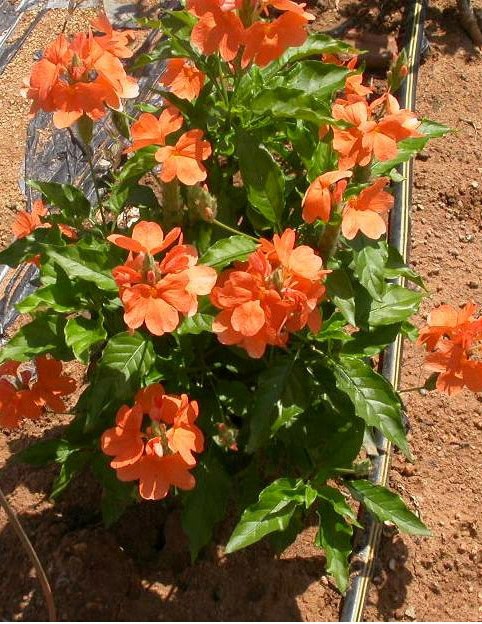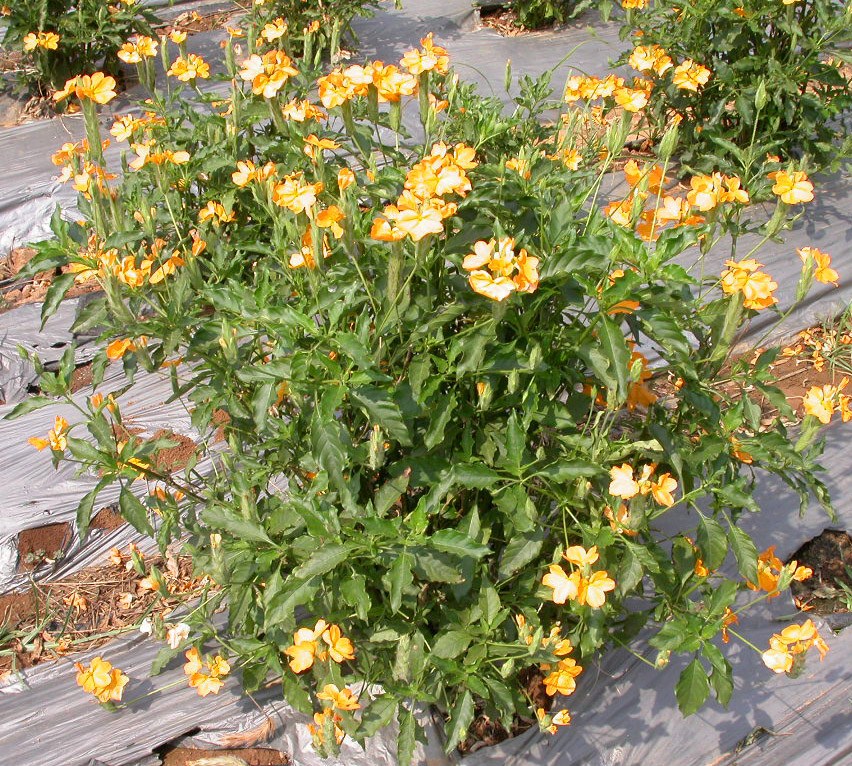
Crop: CROSSANDRA
Scientific name :Crossandra infundibuliformis L.
Common / Local Name :
Crossandra is a herbaceous perennial ever green semi shrub growing to a height of 4ft. Commonly called 'Fire Cracker' plant, it is an important commercial loose flower crop. The flowers are of great demand for use in hair adornments and in the form of garlands, venis and gajras. Though not fragrant, crossandra flowers are very popular because of their attractive bright colour, light weight and good keeping quality. It is a popular loose flower crop in the country, more particularly in the southern region, occupying nearly 15 percent of the area under traditional flowers in Southern states.
Crossandra could be cultivated in a wide range of soils. Fertile, red loamy soils with pH range of 6 to 7.5 are ideal for its cultivation.
Local types (Orange, Dark Red (Ratan aboli), Yellow, Delhi Crossandra , Arka Ambara, Arka Kanaka (IIHR varieties) etc
 Arka Ambara
Arka Ambara
 Arka Kanaka
Arka Kanaka
Propagation is by seeds or stem cuttings. The required seed rate is 5 kg/ha for optimum plant population. Fresh seeds are sown during July - October in raised beds at 15 cm apart in lines. Watering should be done daily. Seedlings are ready for transplanting in 60 days when they have four or five pairs of leaves. In the case of triploid varieties like Delhi, cuttings are used.
Preparation of field
The land has to be ploughed three or four times. FYM @ 25 t/ha is incorporated and mixed well in the soil. Ridges are formed 60 cm apart. A fertilizer dose of 33.3: 60: 60 kg/ha N:P2O5:K2O is applied as basal. Planting of seedlings or rooted cuttings can be done on one side of the ridge at 30 cm spacing. For seed production the spacing may be 60 x 60 cm. The crop is top dressed twice with 33.3 kg N per ha each time, the first at 3 months after transplanting and the second 8-9 months after transplanting. The application of fertilizers is to be necessarily followed by irrigation. Weeding, application of fertilizer and earthing up can be combined together for easy maintenance of the crop.
Irrigation
Irrigation is done once in a week.
Scales, plant bugs and white flies are the important insect pests, which can be controlled by phosalone (0.07%), or methyl parathion (0.01%).
Nematode
Avoid planting Crossandra in nematode infested fields. To control nematodes, apply Phorate or Carbofuran 3 G at 1 kg a.i./ha a week after planting and any one of the above chemicals at 3 and 9 g respectively per metre length after six months of the first application.
Aphids
To control aphids, spray Dimethoate 30 EC 2 ml/lit.
Wilt caused by Fusarium solani will result in yellowing of leaves and death of the plants. The incidence of the disease is found to be more in the presence of root lesion nematode, which can be controlled by application of phorate @ 1 g per plant.
Crop duration
Crossandra flowers within two to three months after planting and continues to bear flowers throughout the year with a lean production season during rainy months. Fully opened flowers are to be picked early in the morning by pulling the corolla out of the calyx. Harvesting of flowers is to be done on alternate days. The yield of flowers is about 5 t/ha.
Yield
An average yield of 2000 kg of flowers per ha/year can be obtained.
Input availability |
Address/Contact details |
| Seeds |
|
Fertilizers |
|
Pesticides |
|
| Machineries |
|
|